White oats are more commonly known as oatmeal. They are available in many forms and provide an excellent source of nutrition. White oats are a smart addition to any kitchen pantry.
Identification
White oats are taken from the common oat plant, a natural whole grain. The plant has a thin, strawlike stem with buds that resemble small teardrops or bells. The oats are taken from the inside of the pods. According to Purdue University's Center for New Crops & Plants Products, the oat plant ranks third on the list of the most important U.S. grain crops.
History
As noted at Iowa State University Agronomy Department's website, the oldest known cultivation of oats dates to the Bronze Age (3300-1200 B.C.). Oats first appeared in North America in 1602, and in 1786, 580 acres of oats were sown by George Washington. In the late 1800s, America saw the founding of Quaker Oats, which marked an increase in the popularity of white oats.
Geography
White oats are speculated to have originated in Asia, according to Iowa State University's Agronomy Department. Oat grains dating to 2000 B.C. also have been found in Egyptian excavation, although these are thought to have been wild oats and not cultivated. The leading producers of oats today are the United States, Russia, Canada, Finland and Poland. In the U.S., oat cultivation occurs primarily in the Midwest.
Types
There are many types of white oats available. The most common cooking types are rolled oats, steel-cut oats and instant oats. Of the three types, steel-cut oats are the most nutritious, but instant oats are the easiest to prepare, as noted at Eatmoreoats.com. Oats also can be bought in their unprocessed form, usually labeled as whole oats, or their partially processed form, hulled oats.
Uses
Oats originally were used primarily as horse feed, but as their nutritional benefits were studied and advertised, they became a popular household food. Oats can be used to make oatmeal cereal, a popular breakfast food, or added into baking recipes such as oatmeal cookies. They are also an ideal thickening agent for cooking soups. As noted at Liveandfeel.com, oats can be used to soothe pain that may result from rheumatism or other ailments. Soaking in a hot oatmeal bath has been known to reduce muscle pain or cramping.
Benefits
Studies have shown many benefits of white oats. They are known to help reduce cholesterol and aid in weight loss and digestion. NutriHealth reports that regular consumption of oats may reduce the chances of heart disease. Oats also are beneficial to those suffering from tobacco or opium withdrawal, according to Eatmoreoats.com.
Related Articles

Bulgar Wheat Vs. Couscous

How to Cook Oat Groats in a Crock Pot

What Is the Difference Between Rolled ...
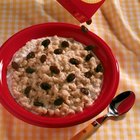
How to Make Quaker Oatmeal

Can I Use Rolled Oats in Place of ...

What Are Yellow Grits?

Difference Between Red Rice & Brown Rice

What Additives Are in Flour?
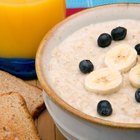
How to Eat Buckwheat Raw

Alternative Flours to Make Pizza

Can I Substitute Rolled Oats for Flour ...

Uses of Cassava Flour
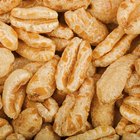
How to Cook With Kamut
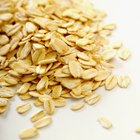
Can You Substitute Quick Cook Oats for ...
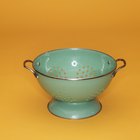
How to Soak Amaranth

Protein Content of Soy Beans

What Is Indian Flatbread Called?

How Many Calories Do Oats Contain?
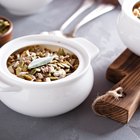
How to Cook Oat Groats in a Slow Cooker
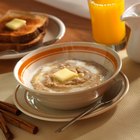
How to Microwave Steel Cut Oats
References
Writer Bio
Nicole Crawford is a NASM-certified personal trainer, doula and pre/post-natal fitness specialist. She is studying to be a nutrition coach and RYT 200 yoga teacher. Nicole contributes regularly at Breaking Muscle and has also written for "Paleo Magazine," The Bump and Fit Bottomed Mamas.